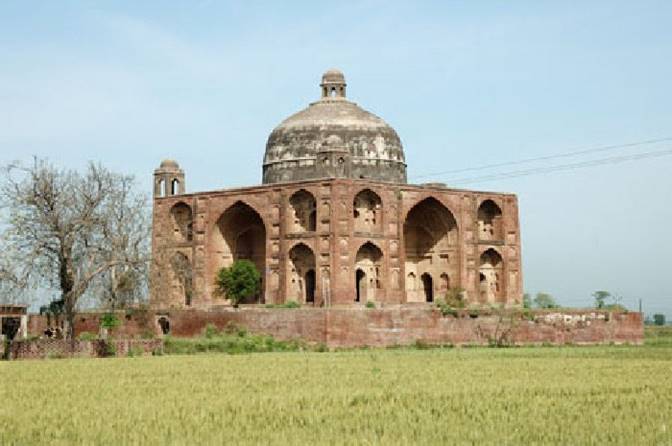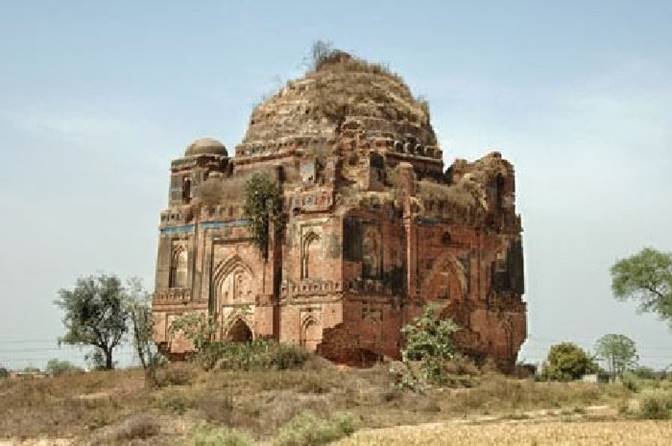Revisiting Banda Singh Bahadur's sack of Sirhind in 1710
By Inderjeet Singh
SikhNet: July 26, 2016
Background

As we commemorate the 300 years of martyrdom of 'rebel' Banda Singh Bahadur and 700 Sikhs at Delhi in 1716 by the Mughal authorities, I would like to review the sack of Sirhind by Banda in 1710. Wazir Khan, Subedar (Governor) of Sirhind was killed by the 'rebels'. Also close aides of the Subedar who were party to the death and martyrdom of two innocent children of Guru Gobind Singh Ji were killed. Needless to say the contemporary historians, who mostly happened to the Muslims, did not have anything nice to say about Banda.
The Dal Khalsa headed by Sardar Jassa Singh Ahluwalia won Sirhind in 1764. The territories of the Sirhind province which were till Yamuna river were divided among the leaders of the Dal Khalsa but no one was willing to take the town of Sirhind where the younger Sahibzades were martyred. According to Sikh Encyclopaedia by Dr Harbans Singh it was given to Buddha Singh, descendant of Bhai Bhagatu, who soon after (2 August 1764) transferred the possession to Sardar Ala Singh, founder of the Patiala ruling family. Later Maharaja Karam Singh of Patiala (1813-45) had Gurdwara Sahibs constructed in Sirhind in memory of the young martyrs and their grandmother.
Allegation
Banda has been accused of sacking the city of Sirhind which they say was next to Lahore in terms of grandeur. It is said that Banda destroyed and desecrated mosques and other Muslims structures in his fury and zeal to take revenge from Wazir Khan (Please see Sikh History from Persian Sources). Based on this, Banda is a hated figure on western side of Punjab. Successive historians and academics have accepted it as a gospel without examining and evaluating the ground realities.
Let us look at the existing Muslims structures in Sirhind which were all built prior to 1710. I am quoting Dr Subhash Parihar who has extensively written on Islamic architecture in Punjab & Haryana regarding the details on Muslim structures in Sirhind. All these structures are in decent condition and have been standing majestically for over 300 years.
|
Mosque of Sadhana Kasai (Butcher) |
The mosque of Sadhana Kasai lies near the railway crossing of Fatehgarh Sahib. It was built by Lodhi dynasty (1451-1526) or during early Mughal period in memory of Saint Sadhana
 |
Ustad Di Mazar (Tomb of Ustad) |
According to Dr Parihar the 'Ustad' was probably Saiyad Khan Chaghatai, a governor of Punjab during the early years of Emperor Jahangir's reign and that he died around 1605-06. Another view is that that this tomb was raised as a memorial to the great architect and builder Ustad Syad Khan.
 |
Shagird Di Mazar (Tomb of Shahgrid) |
Near the tomb of Ustad, there is another beautiful tomb of Khawaja Khan the 'Shagird' (Assistant) of Ustad Syad Khan. He too had attained great proficiency as a builder. This tomb resemble Mughal Emperor Humayun's tomb in Delhi from outside.
Interestingly there are Ustad and Shagrid tombs in Nakodar as well but they belong to different individuals.
 |
Aam Khas Bagh |
The Aam Khas Bagh was built for the public and also for exclusive use of the Mughal Emperor Shah Jahan (1628-58). The Royal couple used to stay here while going to and coming back from Lahore. The resting place or palace is in ruins although the garden is adequately kept.
One can assume that it was destroyed by Banda or by Dal Khalsa in 1764. Another logical explanation could be that it felt into disuse and was not repaired which slowly and steadily over the years led to this state.
  |
Rauza Sharif |
It is the dargah of Shaikh Ahmad Sirhindi who lived here from 1563 - 1624 and was the contemporary of Mughals Emperors Akbar & Jahangir. The large complex also has mosques and number of tombs built by Mughal Emperors. The Urs celebration (death anniversary) of the Shaikh is held here and is largely attended by Muslims from India and neighbouring countries. Interestingly there is a letter from the Shaikh to Murtaza Khan, Governor of Punjab expressing his delight at the martyrdom of Guru Arjan Dev Ji in 1606. This letter in Persian came in public forum only in 20th century.
 |
Tomb of Mir-I-Miran |
The tomb of great saint Mir-I-Miran is the only important building of stone in Sirhind. The daughter of Sultan Bahlol Lodhi (1451-89) was married to a saint, who also built the tomb.
The mosque is under private possession and is situated about 1.5 kms west of the train station of Sirhind. The sanctuary of the mosque is in good condition and most probably built during the reign of Shah Jahan.
 |
Lal Maseet (Red Mosque) |
It is situated just outside the train station of Fatehgarh Sahib. It is said to be built by Shaikh Saifaldin (d 1685). The mosque is in good condition.
 |
Tomb of Taj Bibi (wife of Miran i Mir) |
It is situated in village Talanian about 1.5 kms from Rauza Sharif. The mosque was built by Khwajah Naqshbandi in 1703. Post Independence, this mosque is now used as a Gurdwara Sahib.
The tomb of Bibi Taj, wife of Mir-I-Miran and daughter of Bahlol Lodhi built in 15th century is in state of ruin and neglect but does not bear marks of vandalism or destruction by gun powder.
Myth of 360 mosques in Sirhind
Many historians have quoted that the city of Sirhind in its heydays had 360 mosques and compared it with Lahore. This is a highly exaggerated figure without any basis. Lahore was the capital of Mughal Empire under Jahangir and for many years under Akbar as well. It was also the capital of Punjab under Maharaja Ranjit Singh.
Even today one will not find 360 mosques in Lahore. Sirhind cannot be compared with Lahore. It was just a provincial capital under Mughals. Some historians have used the figure to state that Sirhind had 360 mosques, gardens, tombs, caravan, sarais and wells. Even this figure is exaggerated. It should not be taken literally and basically means a large number but large number of 17th or 18th century would not be a very big number as per today's standards. Hence we cannot say with any certainty about the number of mosques in Sirhind before 1710.
Amritsar was the city of gardens under Maharaja Ranjit Singh. The Maharaja laid down at least a dozen gardens in Amritsar. Now we hardly find 1-2 gardens in the whole city. The haphazard and construction of concrete jungle in our cities has meant we have lost almost all our gardens. Clearly we cannot blame Banda and Dal Khalsa for loss of gardens in Sirhind.
Conclusion
Sirhind lost his royal patronage and became one of cities of Punjab under Sikhs but it is totally wrong to say that it was destroyed by Banda or later by Dal Khalsa. I have given a list of almost a dozen well preserved Islamic structures built prior to 1710. There is a huge difference between destruction and neglect. We are not very good at preserving our heritage. Even structures built by Maharaja Ranjit Singh are facing neglect. The Sikh chroniclers of late 18th and 19th century also proudly state that Banda Singh Bahadur 'ne Sirhind de Eetth Naal Eetth Kharka Diti'. The usage of this idiom to describe the sack of Sirhind is interpreted as destruction of the city.
Mughal history is well documented and we have contemporary official records in Persian. Historians, academics and people who subscribed to the view that Banda (or Dal Khalsa) destroyed and sacked Sirhind (especially Muslim structures) should quote from Mughal records, the names of Mughal or Muslims historical structures which were completed annihilated by Banda and they vanished from the city. If they are unable to name them then it is time to revisit the so called destruction of Sirhind by Banda Singh Bahadur.
